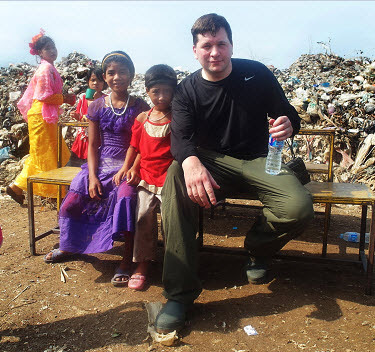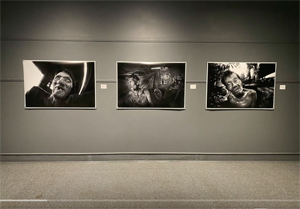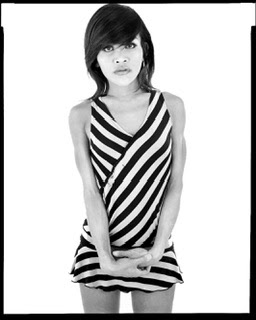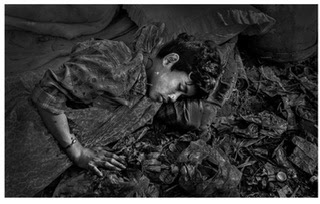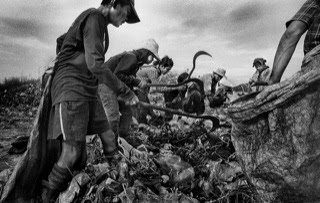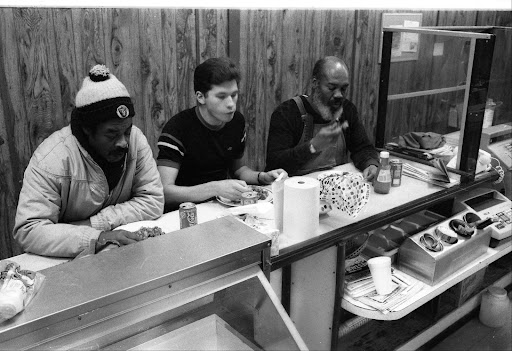This story speaks to the power of photography and both the goodness and evil of man. Nick Ut both helped Kim Phuc (and thousands ofothers) by photographing her and again by not photographing her, when he provided medical aid.
 |
| Pulitzer Prize Winning Photo by Nick Ut 1972 |
 |
| Nick Ut During The Vietnam War |
Here are two recent stories on Kim Phuc and Nick Ut and the legacy they created.
 |
| Kim Phuc And Nick Ut June 2012 |
Woman in iconic Vietnam War photo honoured
CTVNews.ca Staff
Date: Fri. Jun. 8 2012 10:07 PM ET
The woman who became the iconic image of the Vietnam War was reunited with the photographer who made her famous at a dinner held in her honour in Toronto Friday.
June 8 marked the 40-year anniversary of the day Nick Ut took a picture of nine-year-old Kim Phuc as she ran, screaming and naked, away from her village in South Vietnam that had just been set ablaze in a napalm strike.
Happier photos were taken Friday night in Toronto, in the country Phuc has called home for 20 years.
Phuc stood next to the man who captured her image, smiling, and reflecting on how far she has come in 40 years.
"It's marvelous. It changed from darkness into light. From tragedy into love and full of life," said Phuc.
Ut was just 19 when he took the photo.
He quickly stopped taking pictures and tried to help the little girl.
"I looked at her arm and the body skin came off," Ut recalled. "I said ‘Oh my God.' I cried a little bit myself and said, ‘I don't want her to die.'"
Ut's actions are credited with saving that little girl's life.
He poured water on the screaming child and found aid, taking her to the nearest hospital.
Ut was told the little girl was beyond help, with third-degree burns covering more than half of her body.
But Ut demanded that Phuc be treated anyway.
She underwent 17 surgeries. And she survived.
"He took me to the nearest hospital," said Phuc. "If he didn't make that, maybe I'm not here today."
Not only did Ut save Phuc's life, his photo is also credited with bringing the reality of the Vietnam War to North America, and the world.
The Vietnamese news agency that Ut worked for had a policy against publishing nudity, but the photo editor knew that this photo needed to be seen. He broke the rules and published it anyway.
"You know, when I took her picture, I knew we stopped the war in Vietnam. Right away," Ut said.
Ut's photo would go on to win a Pulitzer Prize.
Two decades after the photo was taken, Phuc immigrated to Canada. She is married and has two children.
Today, she travels the world, speaking about peace and the power of forgiveness.
Her power to forgive is an amazing gift, said Denise Chong, author of The Girl in the Picture, a book about Phuc's life and the Vietnam War.
"The power of the photo, and Kim Phuc in particular, is that this most famous casualty of war, that the most powerful thing she has to give, is forgiveness."
On Friday, Phuc was also reunited with Martha Arsenault, the Canadian nurse who treated her back then.
It marked the first time the two met since Arsenault treated the young patient 40 years ago.
"We just hugged each other, cried a little bit," Arsenault said.
Arsenault said treating Phuc made her angry about what war can do to children and, to this day, she is still moved when she sees Ut's photo.
"It reminds me how awful war is and to try to do a little more and have peace in the world," said Arsenault.
At Friday's event, Phuc was also reunited with the British journalist who helped get her into U.S. for plastic surgery, the German journalist who helped her emigrate from Vietnam and the Newfoundland immigration officer who helped her get asylum in Canada.
The woman who became the iconic image of the Vietnam War was reunited with the photographer who made her famous at a dinner held in her honour in Toronto Friday.
June 8 marked the 40-year anniversary of the day Nick Ut took a picture of nine-year-old Kim Phuc as she ran, screaming and naked, away from her village in South Vietnam that had just been set ablaze in a napalm strike.
Happier photos were taken Friday night in Toronto, in the country Phuc has called home for 20 years.
Phuc stood next to the man who captured her image, smiling, and reflecting on how far she has come in 40 years.
"It's marvelous. It changed from darkness into light. From tragedy into love and full of life," said Phuc.
Ut was just 19 when he took the photo.
He quickly stopped taking pictures and tried to help the little girl.
"I looked at her arm and the body skin came off," Ut recalled. "I said ‘Oh my God.' I cried a little bit myself and said, ‘I don't want her to die.'"
Ut's actions are credited with saving that little girl's life.
He poured water on the screaming child and found aid, taking her to the nearest hospital.
Ut was told the little girl was beyond help, with third-degree burns covering more than half of her body.
But Ut demanded that Phuc be treated anyway.
She underwent 17 surgeries. And she survived.
"He took me to the nearest hospital," said Phuc. "If he didn't make that, maybe I'm not here today."
Not only did Ut save Phuc's life, his photo is also credited with bringing the reality of the Vietnam War to North America, and the world.
The Vietnamese news agency that Ut worked for had a policy against publishing nudity, but the photo editor knew that this photo needed to be seen. He broke the rules and published it anyway.
"You know, when I took her picture, I knew we stopped the war in Vietnam. Right away," Ut said.
Ut's photo would go on to win a Pulitzer Prize.
Two decades after the photo was taken, Phuc immigrated to Canada. She is married and has two children.
Today, she travels the world, speaking about peace and the power of forgiveness.
Her power to forgive is an amazing gift, said Denise Chong, author of The Girl in the Picture, a book about Phuc's life and the Vietnam War.
"The power of the photo, and Kim Phuc in particular, is that this most famous casualty of war, that the most powerful thing she has to give, is forgiveness."
On Friday, Phuc was also reunited with Martha Arsenault, the Canadian nurse who treated her back then.
It marked the first time the two met since Arsenault treated the young patient 40 years ago.
"We just hugged each other, cried a little bit," Arsenault said.
Arsenault said treating Phuc made her angry about what war can do to children and, to this day, she is still moved when she sees Ut's photo.
"It reminds me how awful war is and to try to do a little more and have peace in the world," said Arsenault.
At Friday's event, Phuc was also reunited with the British journalist who helped get her into U.S. for plastic surgery, the German journalist who helped her emigrate from Vietnam and the Newfoundland immigration officer who helped her get asylum in Canada.
Woman in Chilling Vietnam War Photo Honors Her Helpers
Published: Saturday, June 9, 2012 at 11:41 p.m.
Last Modified: Saturday, June 9, 2012 at 11:41 p.m.
TORONTO | It was a chilling photograph that came to symbolize the horrors of the Vietnam War and, ultimately, helped end it.
It also saved the life of Kim Phuc, who was just 9 years old when, on June 8, 1972, her village was attacked by south Vietnamese planes.
Phuc, who lives near Toronto with her family, honored those who saved her at a dinner Friday to celebrate the 40th anniversary of the iconic photograph. They include AP photographer Huynh Cong "Nick" Ut, who snapped the shot, as well as other journalists, doctors and nurses who helped her get help and who treated her injuries.
Ut, who was 21 at the time, heard Phuc's screams as she ran down the road to escape her burning village, and snapped the photo that became famous around the world.
The Vietnamese photographer then drove the badly burned child to a small hospital, where he was told she was too far gone to help. He flashed his American press badge, demanded that doctors treat the girl and left assured that she would not be forgotten.
"I'm so grateful he was there," Phuc said. "He helped me and rushed me to the nearest hospital. He saved my life. He's my hero. This opportunity tonight I want to honor all of my personal heroes."
Ut said he cried when he saw her running. He said if he didn't help and she died he would have killed himself. He knew right way this picture was different and said veteran photo editor, Horst Faas, deemed it the most the iconic photo of the Vietnam war.
"It changed the war. I met so many American soldiers who said ‘Nicky, because of your picture I'll get to go home early,' " he said.
In the Pulitzer Prize-winning image, children run screaming from a burning Vietnamese village. The little girl in the center of the frame, Phuc, is naked and crying, her clothes and layers of skin melted away by napalm.
A few days after the image shocked the world, a number of British journalists including Christopher Wain, a correspondent for the British Independent Television Network who had given Phuc water from his canteen and drizzled it down her burning back at the scene, fought to have her transferred to the American-run hospital.
Martha Arsenault, a nurse at the American hospital, said when Phuc got to the hospital nobody thought she'd make it.




